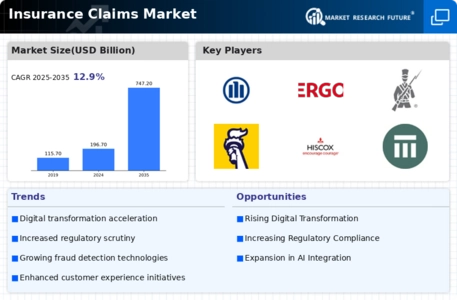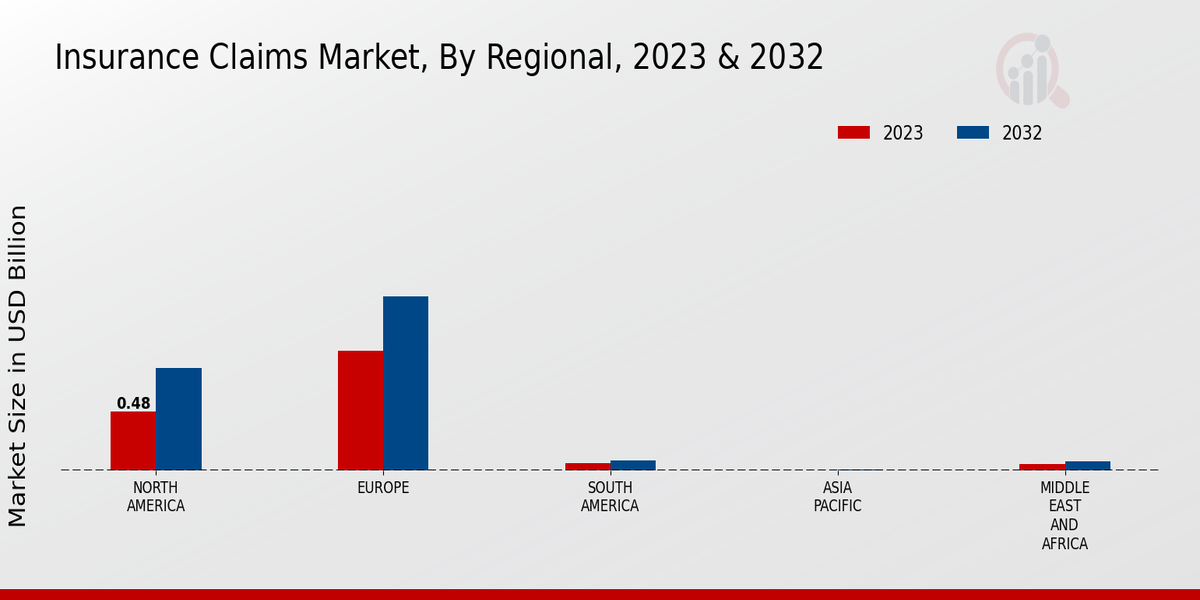Market Growth Projections
The Global Insurance Claims Market Industry is poised for substantial growth, with projections indicating a rise from 196.7 USD Billion in 2024 to 747.2 USD Billion by 2035. This growth trajectory suggests a compound annual growth rate of 12.9% from 2025 to 2035. Various factors contribute to this expansion, including technological advancements, increasing consumer awareness, and demographic shifts. As the market evolves, insurers are likely to innovate their claims processes to accommodate the growing demand. This upward trend in market size reflects the industry's resilience and adaptability in the face of changing consumer needs and external challenges.
Technological Advancements
The Global Insurance Claims Market Industry is experiencing a transformative phase driven by technological advancements. Innovations such as artificial intelligence and machine learning are streamlining claims processing, enhancing efficiency and accuracy. For instance, AI algorithms can analyze claims data rapidly, reducing the time taken for claim approvals. This technological shift is expected to contribute to the market's growth, with projections indicating a rise from 196.7 USD Billion in 2024 to 747.2 USD Billion by 2035. The integration of these technologies not only improves customer satisfaction but also reduces operational costs for insurers, thereby fostering a more competitive landscape.
Regulatory Changes and Compliance
Regulatory changes play a crucial role in shaping the Global Insurance Claims Market Industry. Governments worldwide are implementing stricter regulations to protect consumers and ensure fair practices within the insurance sector. These regulations often require insurers to enhance their claims handling processes, leading to increased operational efficiency. As compliance becomes a priority, insurers are investing in systems that facilitate adherence to these regulations. This trend is expected to drive market growth, with the industry projected to reach 747.2 USD Billion by 2035. The evolving regulatory landscape may also encourage innovation in claims management, further benefiting consumers.
Demographic Shifts and Urbanization
Demographic shifts and urbanization are pivotal factors driving the Global Insurance Claims Market Industry. As populations grow and urban areas expand, the demand for various insurance products increases, leading to a higher volume of claims. Younger generations, who are more inclined to purchase insurance, are entering the market, further contributing to this trend. The industry is expected to experience a compound annual growth rate of 12.9% from 2025 to 2035, reflecting the growing need for insurance coverage in urban settings. Insurers are adapting their offerings to meet the evolving needs of these demographics, which is likely to enhance the claims process.
Rising Incidence of Natural Disasters
The Global Insurance Claims Market Industry is significantly influenced by the rising incidence of natural disasters. As climate change leads to more frequent and severe weather events, the demand for insurance claims related to property damage is increasing. Insurers are facing mounting pressure to process these claims efficiently and effectively. This trend is likely to contribute to the market's growth, with projections indicating an increase from 196.7 USD Billion in 2024 to 747.2 USD Billion by 2035. The heightened risk associated with natural disasters necessitates that insurers adapt their strategies to manage claims more effectively, thereby shaping the future of the industry.
Increasing Awareness of Insurance Products
The Global Insurance Claims Market Industry is witnessing a surge in consumer awareness regarding various insurance products. As individuals become more informed about the benefits of insurance, the demand for claims is likely to increase. This heightened awareness is driven by educational campaigns and digital platforms that provide easy access to information. Consequently, the market is projected to grow significantly, with an anticipated compound annual growth rate of 12.9% from 2025 to 2035. Insurers are responding by enhancing their product offerings, which further stimulates the claims process and contributes to the overall market expansion.




















